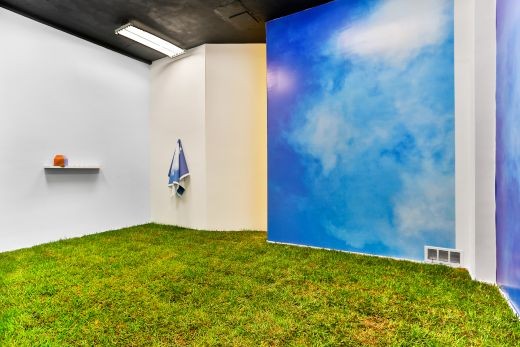Second Nature
Laura Randall

José Luis Falconi, Second Nature, 2015. Grass, digital print, and wood. Photo: Christian Hernandez. Courtesy Jenielift, Miami
OCTOBER 10–NOVEMBER 21, 2015
Every day at 8395 NE 2nd Ave, a group of local residents congregate inside a hot and barren commercial building in Little Haiti for worship. Inside, it is as if the desecration and destruction of the Reformation just carried over, but without the fresh paint—no pews coming later, just a strikingly bleak room for worship. They gather inside a tight, non-air-conditioned room fitted with a few old sofas and folding chairs. The largely Creole-speaking laity have been working around and talking with the new tenants in their building, artists Marla Rosen and Eddie Negron for several months now.
“They didn’t like Eddie at first,” Marla tells me at their most recent opening at their gallery, Jenielift. She and Eddie opened the new alternative exhibition space in July. There are no signs for the gallery; the door is marked out front by its neighbor (with whom they share a vestibule), the Missionary Baptist Church. Nestled between Mindy Solomon Gallery and Guccivuitton, Jenielift has positioned itself as a discreet but poignant feature on the block.
Second Nature, a solo show by José Luis Falconi, makes clear Jenielift’s aim to challenge the traditional role of the gallery or contemporary project space. Falconi has transformed the four-hundred-square-foot gallery into a more aestheticized contemporary space we don’t often see in Miami. The walls are covered in a sleek digital print of ethereal clouds and bright blue skies, which hover over freshly laid St. Augustine grass. The perfectly manicured lawn and sweeping sky evoke images of suburban life, a democratic emblem that belies its roots in the aristocratic gardens of the 18th century, yet here it provides a brief respite from the largely dilapidated block.
The name Jenielift was borrowed from the machinery museum staff and artists use to install large works and technical lighting. The gallery plans to continue exploring the veiled properties contained within objects and habits of daily life. The next show will feature Sergio Vega, whose artwork explores the physical traces of a prelapsarian world along the Amazon through archival documentation, multimedia installations, and photography. At first, Missionary Baptist Church was skeptical of how their new neighbors had reconfigured their shared space, but after seeing the juxtaposition of heaven and earth in Falconi’s work, they came to embrace what Rosen and Negron have created.









